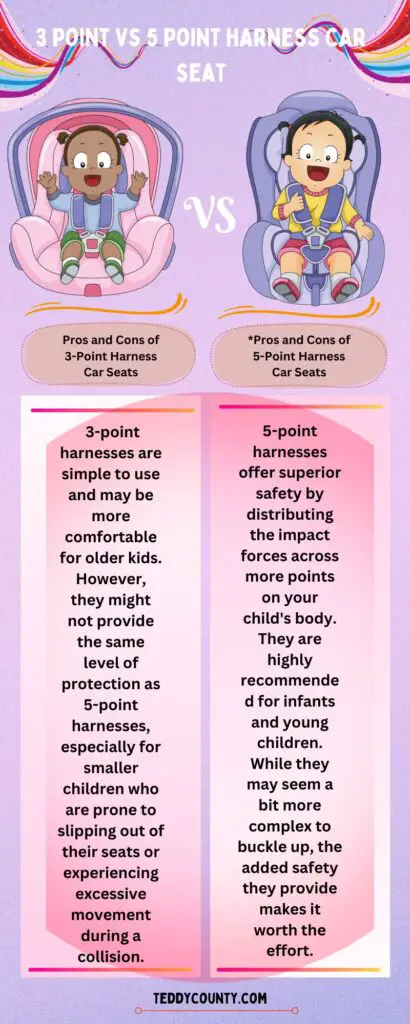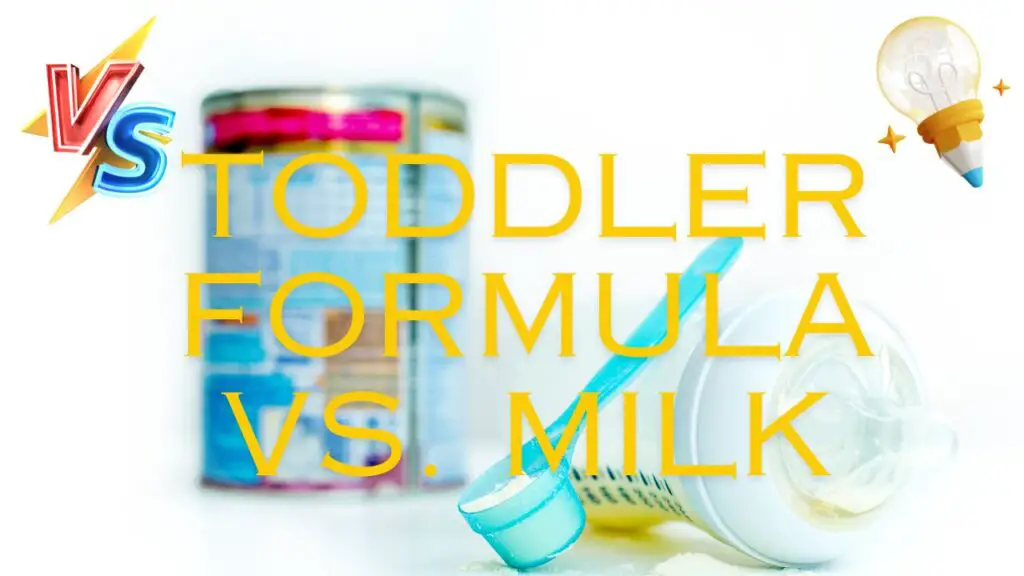Safety First: The Pros and Cons of 3-Point and 5-Point Harness Car Seats
3 Point VS 5 Point Harness Car Seat: When it comes to the safety of our children, nothing should be left to chance. Choosing the right car seat is one of the most important decisions parents make to protect their little ones on the road. Two popular options that often come up in discussions are the 3-point and 5-point harness car seats. But which one is the best choice? In this article, we will dive deep into the pros and cons of both the 3-point and 5-point harness car seats, to help you make an informed decision. The 3-point harness car seat, with straps that secure the child at three points – over the shoulders and across the hips – is a basic and common choice. On the other hand, the 5-point harness car seat distributes the impact forces across the body with the added security of two straps securing the child at the hips. Join us as we explore the benefits and drawbacks of both types of car seats, so you can choose the one that best meets your needs and provides the utmost safety for your child during every ride.
3 Point vs 5 Point Harness
A 3-point harness secures the child at the shoulders and between the legs. However, a 5-point harness offers enhanced safety. It secures the child at five points: both shoulders, both hips, and between the legs. This additional security at the hips is crucial in preventing the child from sliding out in case of an accident, especially in roll-over scenarios.
Importance of car seat safety
Car seat safety is not just about following the law; it’s about protecting your most precious cargo—your child. Properly secured car seats can significantly reduce the risk of injury or death in a car accident. It’s like a seatbelt for your little one, and it’s crucial to use one that’s suitable for your child’s age, weight, and height.
Different Types of Car Seat Harnesses
Car seats come in various harness systems, including 3-point and 5-point harnesses. A 3-point harness secures your child with straps over the shoulders and between the legs, while a 5-point harness adds two more straps over your child’s hips. The latter offers enhanced safety and is generally recommended for infants and toddlers.

Factors to Consider When Choosing Between a 3-Point and 5-Point Harness Car Seat
When choosing between a 3-point and a 5-point harness car seat, several essential factors come into play:
1. Age and Size of Your Child:
Consider your child’s age, weight, and height. 3-point harnesses are often suitable for older children, while 5-point harnesses are recommended for infants and toddlers due to their enhanced safety.
2. Safety Standards:
Ensure that the car seat you choose meets safety standards and regulations in your country. Look for seats that have been tested and certified for safety.
3. Vehicle Size and Layout:
The type of car you have can impact your choice. Some car seats may not fit well in certain vehicles. Check the car seat’s compatibility with your vehicle before purchasing.
4. Longevity of Use:
Think about how long you plan to use the car seat. Some 5-point harness seats can accommodate larger children, offering extended use compared to 3-point harness seats.
5. Ease of Use:
Consider your convenience. 3-point harnesses are often simpler to buckle and unbuckle, which can be beneficial if you frequently move the car seat between vehicles.
6. Child’s Comfort:
Ensure that your child is comfortable in the car seat. Some children may prefer the fit and feel of one harness type over the other, so consider your child’s comfort and preferences.
7. Safety Record:
Research the safety record and reviews of the specific car seat models you’re considering. The real-world experiences of other parents can provide valuable insights.
8. Budget:
Car seats come in a wide price range. Set a budget and try to find the best car seat within your price range that meets safety and comfort requirements.
9. Ease of Installation:
Check if the car seat is easy to install correctly. Proper installation is crucial for safety, so choose one that you can confidently install in your vehicle.
10. Future Needs:
Think about your future needs. If you plan on having more children, a car seat that can accommodate multiple stages of growth might be a wise investment.
11. Professional Guidance:
If you’re unsure which harness type is best for your child, seek advice from a certified car seat technician. They can provide personalized recommendations based on your child’s specific needs.
Read Also:
Safety Regulations and Standards for Car Seat Harnesses
Ensure that the car seat you choose complies with safety regulations and standards in your country. These standards are there to guarantee that the seat meets minimum safety requirements.
When it comes to ensuring the safety of car seat harnesses, several regulations and standards are in place to provide a benchmark for manufacturers and consumers. These regulations and standards are crucial to guarantee that car seats meet minimum safety requirements. Here’s an overview:
Federal Motor Vehicle Safety Standards (FMVSS)
In the United States, the National Highway Traffic Safety Administration (NHTSA) establishes FMVSS regulations that car seat manufacturers must comply with. FMVSS 213 specifically addresses child restraint systems, including car seats. It sets forth requirements for crash testing, structural integrity, labeling, and user instructions.
European Safety Standards (ECE R44/04 and R129)
In Europe, car seats must meet ECE regulations, specifically ECE R44/04 and R129 (i-Size). These standards specify safety requirements and testing methods, covering aspects such as impact testing, design, and labeling. The i-Size standard introduces new regulations to enhance safety, including rear-facing travel for longer periods.
Canadian Motor Vehicle Safety Standards (CMVSS)
Canada has its own safety standards for car seats, outlined in the CMVSS regulations. These standards address various aspects of child restraint systems, including design, materials, labeling, and crash testing.
Child Passenger Safety Certification
Beyond government regulations, there are additional certifications, such as the JPMA (Juvenile Products Manufacturers Association) certification in the U.S. and the TÜV certification in Europe. These certifications provide further assurance of a product’s safety and quality.
Expiration Dates
Car seats often have expiration dates specified by the manufacturer. It’s essential to adhere to these dates, as materials can degrade over time, compromising safety.
User Manuals and Labels
Car seats must come with clear and comprehensive user manuals. Labels on the seat provide important information, such as the weight and height limits for the seat, as well as proper installation instructions.
Expiration Dates
Car seats often have expiration dates specified by the manufacturer. It’s essential to adhere to these dates, as materials can degrade over time, compromising safety.
User Manuals and Labels
Car seats must come with clear and comprehensive user manuals. Labels on the seat provide important information, such as the weight and height limits for the seat, as well as proper installation instructions.
Testing and Certification
Manufacturers are required to crash-test their car seats to ensure they meet safety standards. Look for seats that have been certified through rigorous testing.
Recalls and Safety Notices
Stay informed about recalls and safety notices for your car seat model. Manufacturers issue recalls to address safety concerns, and it’s vital to act promptly if your car seat is affected.
Local Regulations
In addition to national standards, some regions or states may have their specific regulations or requirements for child restraint systems. Always check local laws to ensure compliance.
Tips for Proper Installation and Usage of Car Seat Harnesses
Let’s dive into some essential tips for properly installing and using car seat harnesses:
1. Read the Manual:
It may seem obvious, but many parents skip this step. Always start by thoroughly reading the car seat manual. Each seat can have unique installation instructions and usage guidelines. Ignoring this step can lead to critical errors.
2. Choose the Right Seat:
Ensure that the car seat you select is suitable for your child’s age, weight, and height. Never rush the transition to a bigger seat; it’s crucial to follow the manufacturer’s recommendations.
3. Install in the Rear-Facing Position:
For infants and young toddlers, it’s safer to install the car seat in a rear-facing position. This protects their neck and spine in case of an accident. Keep your child rear-facing as long as possible, according to the car seat’s weight and height limits.
4. Use the Tether Strap:
If you’re installing a forward-facing seat, always use the tether strap. This additional strap secures the top of the car seat to an anchor point in your vehicle, reducing head movement in a crash.
5. Check the Angle:
nsure that the car seat is at the correct angle. Most seats have built-in angle indicators or guidelines in the manual to help you adjust it properly. A seat that’s too upright or too reclined can be dangerous.
6. Securely Fasten the Harness:
Buckle up your child snugly but comfortably. Make sure the harness straps lie flat and are not twisted. You should be able to fit only one or two fingers between your child’s collarbone and the harness strap.
7. Chest Clip Placement:
The chest clip should be positioned at armpit level, not too low on the belly or too high on the neck. It’s there to keep the harness straps properly positioned.
8. No Bulky Clothing:
Avoid dressing your child in bulky clothing or using aftermarket accessories like seat belt pads or cushions. These can interfere with the harness’s proper fit. Instead, use a blanket over the harness to keep your child warm.
9. Regularly Check for Tightness:
Car seats can become loose over time due to vibrations from driving. Periodically, check the tightness of the installation and harness straps. Make it a habit to do this before every trip.
10. Replace After an Accident:
If your vehicle is involved in a moderate-to-severe accident, replace the car seat, even if it looks undamaged. The forces in an accident can weaken the seat’s structure, rendering it less effective in subsequent collisions.
11. Get Professional Help:
If you’re unsure about the installation or need reassurance that you’ve done it correctly, don’t hesitate to seek professional help. Many car seat inspection stations and certified technicians can check your installation for free.
Remember, using a car seat correctly is a vital part of keeping your child safe while traveling. Following these tips ensures that you’re providing the best protection for your little one on the road.
Real-Life Stories and Testimonials
Certainly, let’s talk about real-life stories and testimonials regarding car seat harnesses. Hearing from parents who have experienced the benefits of 3-point and 5-point harness car seats can provide valuable insights and encouragement for those considering their options.
Real-Life Story 1: The 5-Point Harness Savior
I’ll never forget the day my wife and I were in a car accident. Our son was securely strapped into his 5-point harness car seat. The impact was frightening, but when we checked on our little one, he was completely unharmed. The 5-point harness had kept him snug and secure, and that moment affirmed our choice of car seats. It was a stark reminder that investing in safety is always worth it.
Real-Life Story 2: Peace of Mind with a 3-Point Harness
When our daughter outgrew her infant seat, we opted for a 3-point harness convertible car seat. It was incredibly easy to install, and it provided the comfort she needed as a toddler. One day, another driver rear-ended us, and the sudden jolt was terrifying. But seeing our daughter emerge from the incident without a scratch was nothing short of a miracle. That 3-point harness had done its job impeccably, and we were beyond grateful.
Testimonial 1: Sarah’s Story:
Sarah, a close friend of mine, shared her experience with a 5-point harness car seat. She told me how her car was T-boned at an intersection, and her toddler was in the back seat. The 5-point harness held her child securely, and even though the car was severely damaged, her little one was just fine. Sarah said it was the scariest day of her life, but the car seat gave her peace of mind. she’d never trade for anything.
Testimonial 2: David’s Journey:
David, another friend, shared his journey with a 3-point harness booster seat for his son. He mentioned how the seat grew with his child, accommodating his growth stages. Recently, they were in a minor fender bender, and the seat kept his son safe and unharmed. David emphasized the convenience of the 3-point harness and how it made their daily commute worry-free.
These real-life stories and testimonials underscore the importance of choosing the right car seat harness for your child’s safety. Whether it’s a 3-point or 5-point harness, when used correctly, they can be lifesaving tools that provide parents with peace of mind during every journey. Remember, safety always comes first when it comes to our little ones!
Recommendations for the Best 3-Point and 5-Point Harness Car Seats
When it comes to specific product recommendations, do your research, read reviews, and consult with experts or fellow parents to find the best car seat that suits your needs. Choosing the best car seat harness is crucial for your child’s safety.
Here are some recommendations for both 3-point and 5-point harness car seats:
Best 3-Point Harness Car Seats:This versatile seat is designed for children, from toddlers to youth. It offers a 3-point harness for younger children and then transitions into a high-back booster and backless booster as your child grows.
Disclaimer: : Teddycounty participates in the Amazon Associates program. We may receive a commission if you purchase via our website at no additional cost to you.
Graco Tranzitions 3-in-1 Harness Booster Car Seat:
This versatile seat is designed for children from toddlers to youth. It offers a 3-point harness for younger children and then transitions into a high-back booster and backless booster as your child grows.
Britax Grow with You Harness-to-Booster
2-in-1 Harness-to-Booster Seat: Easily transitions from forward-facing harness mode to belt-positioning booster mode as your child grows from toddler to big kid
Evenflo Revolve360 Extend All-in-One Rotational Car Seat
Grows with your child for 10 years with 3 modes that adapt to every stage — rear-facing (4 to 50 lb), forward-facing (22 to 65 lb) and booster (40 to 120 lb)
budget-friendly option provides a secure 5-point harness for children weighing up to 50 pounds. It’s lightweight and easy to install, making it a practical choice for many families.
Best 5-Point Harness Car Seats:
Britax One4Life ClickTight All-in-One Car Seat
Britax is renowned for safety, and the Frontier is no exception. It features ClickTight installation for easy and secure fitting, a 5-point harness, and the ability to convert into a booster seat as your child grows.
Diono Radian 3R, 3-in-1 Convertible Car Seat
This all-in-one car seat accommodates rear-facing, forward-facing, and booster modes. It comes with a 5-point harness for younger kids and boasts a steel frame for extra durability.
Evenflo Revolve360 Slim 2-in-1 Rotational Car Seat
This seat offers both a 5-point harness and an easy transition into a belt-positioning booster. It’s budget-friendly and provides extended rear-facing capabilities for added safety.
When choosing a car seat, always consider your child’s age, weight, and height, as well as your vehicle’s size and layout. Additionally, make sure the car seat complies with safety regulations in your region. Remember that the best car seat is one that fits your child snugly and is installed correctly. Always consult the manufacturer’s guidelines and seek professional help if needed to ensure your child’s safety on the road.
Conclusion
In conclusion, when choosing between a 3-point and a 5-point harness for a car seat, the paramount consideration should always be the safety and comfort of your child. A 5-point harness, offering superior security with its additional points of contact, is generally the recommended choice, especially for younger children and infants. However, for older children, a 3-point harness can provide adequate safety and more comfort. As a parent or caregiver, it’s crucial to weigh the specific needs of your child, considering their age, size, and the unique features of each car seat model. We encourage you to prioritize safety in your decision and consult with child safety experts if in doubt. Remember, the right car seat can make all the difference in ensuring your child’s safety during every journey. Act now to ensure your child is secured in the best possible way.


